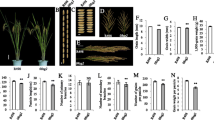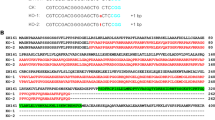Abstract
A new possibility for genetic control of the protein content of rice grains was suggested by the allele differences of the SEMIDWARF1 (SD1) mutation. Two quantitative trait loci—qPROT1 and qPROT12—were found on chromosomes 1 and 12, respectively, using backcrossed inbred lines of Sasanishiki/Habataki//Sasanishiki///Sasanishiki. One of them, qPROT1, increased almost all grain proteins instead of only certain proteins in the recessive Habataki allele. Fine mapping of qPROT1 revealed that two gene candidates—Os01g0883800 and Os01g0883900—were included in this region. Os01g0883800 encoded Gibberellin 20 oxidase 2 as well as SD1, the dwarf gene used in the so-called ‘Green Revolution’. Mutant analyses as well as sequencing analysis using the semi-dwarf mutant cultivars Dee-geo-woo-gen and Calrose 76 revealed that the sd1 mutant showed significantly higher grain protein contents than their corresponding wild-type cultivars, strongly suggesting that the high protein contents were caused by sd1 mutation. However, the sd1 mutant Reimei did not have high grain protein contents. It is possible to control the grain protein content and column length separately by selecting for sd1 alleles. From this finding, the genetic control of grain protein content, as well as the column length of rice cultivars, might be possible. This ability might be useful to improve rice nutrition, particularly in areas where the introduction of semi-dwarf cultivars is not advanced.






Similar content being viewed by others
Abbreviations
- CAPS:
-
Cleaved amplified polymorphic sequence
- CTAB:
-
Cetyl trimethyl ammonium bromide
- GLM:
-
General linear model
- LOD:
-
Logarithm of odds
- NaOH:
-
Sodium hydroxide
- PCR:
-
Polymerase chain reaction
- QTL:
-
Quantitative trait locus
- RFLP:
-
Restriction fragment length polymorphism
- SDS:
-
Sodium dodecyl sulfate
- SSR:
-
Simple sequence repeat
- STS:
-
Sequence-tagged sites
References
Aluko G, Martinez C, Tohme J, Castano C, Bergman C, Oard JH (2004) QTL mapping of grain quality traits from the interspecific cross Oryza sativa x O. glaberrima. Theor Appl Genet 109:630–639
Asano K, Hakashi T, Miura K, Qian Q, Kitano H, Matsuoka M, Ashikar M (2007) Genetic and molecular analysis of utility of sd1 alleles in rice breeding. Breed Sci 57:53–58
Ashikari M, Sasaki A, Ueguchi-Tanaka M, Itoh H, Nishimura A, Datta S, Ishiyama K, Saito T, Kobayashi M, Khush GS, Kitano H, Matsuoka M (2002) Loss-of-function of a rice gibberellin biosynthetic gene, GA20 oxidase (GA20ox-2), led to the rice ‘Green Revolution’. Breed Sci 52:143–150
Finnegan EJ, Genger RK, Peacock WJ, Dennis ES (1998) DNA methylation in plants. Annu Rev Plant Physiol 49:223–247
Hu Z-L, Li P, Zhou M-Q, Zhang Z-H, Wang L-X, Zhu L-H, Zhu Y-G (2004) Mapping of quantitative trait loci (QTLs) for rice protein and fat content using doubled haploid lines. Euphytica 135:47–54
Iida S, Amano E, Nishio T (1993) A rice (Oryza sativa L.) mutant having a low content of glutelin and a high content of prolamine. Theor Appl Genet 87:374–378
International Rice Genome Sequencing Project (2005) The map-based sequence of the rice genome. Nature 436:793–800
Joehanes R, Nelson JC (2008) QGene 4.0, an extensible Java QTL-analysis platform. Bioinformatics 24:2788–2789
Jones DB (1941) Factors for converting percentages of nitrogen in foods and feeds into percentages of proteins. Circular no. 183. United States Department of Agriculture, Washington
Kennedy G, Burlingame B, Nguyen VN (2003) Nutritional contribution of rice and impact of biotechnology and biodiversity in rice-consuming countries. In: Van Tran D (ed) Sustainable rice production for food security: Proceedings of the 20th Session of the International Rice Commission, Bangkok, Thailand, 23–26 July 2002. FAO, Rome
Kikuchi F, Itakura N, Ikehashi H, Yokoo M, Nakane A, Maruyama K (1985) Genetic analysis of semi-dwarfism in high yielding rice varieties in Japan. Bull Natl Ins Agr Sci Ser D 36:125–145
Kuroda M, Kimizu M, Mikami C (2010) A simple set of plasmids for the production of transgenic plants. Biosci Biotechnol Biochem 74:2348–2351
Liu X, Wan X, Ma X, Wan J (2011) Dissecting the genetic basis for the effect of rice chalkiness, amylose content, protein content, and rapid viscosity analyzer profile characteristics on the eating quality of cooked rice using the chromosome segment substitution line population across eight environments. Genome 54:64–80
Matsue Y, Odahara K, Hiramatsu M (1994) Differences in protein content, amylose content and palatability in relation to location of grains within rice panicle. Jpn J Crop Sci 63:271–277
Matsue Y, Odahara K, Hiramatsu M (1997) Studies on palatability of rice in northern Kyushu. VIII. Nitrogen fertilizer and zeolite application for improving the eating-quality of rice produced on Andosol paddy field. Jpn J Crop Sci 66:189–194
Matsue Y, Sato H, Uchimura Y (2001) The palatability and physicochemical properties of milled rice for each grain-thickness group. Plant Prod Sci 4:71–76
McCouch SR, Teytelman L, Xu Y, Lobos KB, Clare K, Walton M, Fu B, Maghirang R, Li Z, Xing Y, Zhang Q, Kono I, Yano M, Fjellstrom R, DeClerck G, Schneider D, Cartinhour S, Ware D, Stein L (2002) Development and mapping of 2240 new SSR markers for rice (Oryza sativa L.). DNA Res 9:199–207
Miura K, Horiuchi H, Kobayashi A, Koga Y, Okuno K, Fujita Y, Uchiyamada H (1991) Breeding process and characteristics of a new rice variety “HABATAKI”. Hokuriku Crop Sci 26:52–55 (in Japanese)
Mohanty S (2013) Trends in global rice consumption. IRRI. http://irri.org/rice-today/trends-in-global-rice-consumption. Accessed 24 Apr 2014
Murai M, Yamamoto H (2001) Allelic relationships and height effects of rice dwarfing genes from cvv. Dee-geo-woo-gen, Calrose 76 and Reimei determined in a constant genetic background. SABRAO J Breed Genet 33:21–30
Murai M, Takamura I, Sato S, Tokutome T, Sato Y (2002) Effects of the dwarfing gene originating from ‘Dee-geo-woo-gen’ on yield and its related traits in rice. Breed Sci 52:95–100
Nagata K, Fukuta Y, Shimizu H, Yagi T, Terao T (2002) Quantitative trait loci for sink size and ripening traits in rice (Oryza sativa L.). Breed Sci 52:259–273
Nelson JC (1997) QGENE: software for marker-based genomic analysis and breeding. Mol Breed 3:239–245
Nelson B (2008) New food enhancements prove more palatable. Non-genetically modified techniques smooth ice cream, boost protein in rice. Frontiers on NBC NEWS.com. http://www.nbcnews.com/id/24281450/ns/technology_and_science-innovation/t/new-food-enhancements-prove-more-palatable/. Accessed 24 Apr 2014
Payne PI (1987) Genetics of wheat storage proteins and the effect of allelic variation on bread-making quality. Ann Rev Plant Physiol 38:141–153
Sasaki A, Ashikari M, Ueguchi-Tanaka M, Itoh H, Nishimura A, Swapan D, Ishiyama K, Saito T, Kobayashi M, Khush GS, Kitano H, Matsuoka M (2002) Green revolution: a mutant gibberellin-synthesis gene in rice. Nature 416:701–702
Shewry PR, Halford NG (2002) Cereal seed storage proteins: structures, properties and role in grain utilization. J Exp Bot 53:947–958
Song Y-J, Choi I-Y, Sharma PK, Kang C-H (2012) Effect of different nitrogen doses on the storage proteins and palatability of rice grains of primary and secondary rachis branches. Plant Prod Sci 15:253–257
Tan YF, Sun M, Xing YZ, Hua JP, Sun XL, Zhang QF, Corke H (2001) Mapping quantitative trait loci for milling quality, protein content and color characteristics of rice using a recombinant inbred line population derived from an elite rice hybrid. Theor Appl Genet 103:1037–1045
Temnykh S, DeClerck G, Lukashova A, Lipovich L, Cartinhour S, McCouch S (2001) Computational and experimental analysis of microsatellites in rice (Oryza sativa L.): frequency, length variation, transposon associations, and genetic marker potential. Genome Res 11:1441–1452
Terao T, Miura S, Yanagihara T, Hirose T, Nagata K, Tabuchi H, Kim H-Y, Lieffering M, Okada M, Kobayashi K (2005) Influence of free-air CO2 enrichment (FACE) on the eating quality of rice. J Sci Food Agric 85:1861–1868
Terao T, Nagata K, Morino K, Hirose T (2010) A gene controlling the number of primary rachis branches also controls the vascular bundle formation and hence is responsible to increase the harvest index and grain yield in rice. Theor Appl Genet 120:875–893
Tilman D, Cassman KG, Matson PA, Naylor R, Polasky S (2002) Agricultural sustainability and intensive production practices. Nature 418:671–677
Uauy C, Distelfild A, Fahima T, Blechl A, Dubcovsky J (2006) A NAC gene regulating senescence improves grain protein, zinc, and iron content in wheat. Science 314:1298–1301
Wan XY, Wan JM, Su CC, Wang CM, Shen WB, Li JM, Wang HL, Jiang L, Liu SJ, Chen LM, Yasui H, Yoshimura A (2004) QTL detection for eating quality of cooked rice in a population of chromosome segment substitution lines. Theor Appl Genet 110:71–79
Wang H, Qi M, Cutler AJ (1993) A simple method of preparing plant samples for PCR. Nucleic Acids Res 21:4153–4154
Ye G, Liang S, Wan J (2010) QTL mapping of protein content in rice using single chromosome segment substitution lines. Theor Appl Genet 121:741–750
Yoshida S, Ikegami M, Kuze J, Sawada K, Hashimoto Z, Ishii T, Nakamura C, Kamijima O (2002) QTL analysis for plant and grain characters of Sake-brewing rice using a doubled haploid population. Breed Sci 52:309–317
Yun B-W, Kim M-G, Handoyo T, Kim K-M (2014) Analysis of rice grain quality-associated quantitative trait loci by using genetic mapping. Am J Plant Sci 5:1125–1132
Zheng L, Zhang W, Chen X, Ma J, Chen W, Zhao Z, Zhai H, Wan J (2011) Dynamic QTL analysis of rice protein content and protein index using recombinant inbred lines. J Plant Biol 54:321–328
Zheng Z, Zhang W, Liu S, Chen L, Liu X, Chen X, Ma J, Chen W, Zhao Z, Jiang L, Wan J (2012) Genetic relationship between grain chalkiness, protein content, and paste viscosity properties in a backcross inbred population of rice. J Cereal Sci 56:153–160
Acknowledgments
This work was partly supported by JSPS KAKENHI Grant Number 24580030. We are grateful to Mr. Tokuya Genba, Mr. Tuyoshi Kotake, Mr. Masanori Ichihashi, Mr. Shinobu Yuminamochi, Mr. Koushi Yazaki, Mr. Susumu Saitou, Mr. Ken-ichi Koide, Ms. Keiko Nozaki and Ms. Setsuko Hayashi for their excellent technical assistance.
Conflict of interest
The authors declare that they have no conflicts of interest.
Author information
Authors and Affiliations
Corresponding author
Additional information
Communicated by S. Hohmann.
Electronic supplementary material
Below is the link to the electronic supplementary material.
Rights and permissions
About this article
Cite this article
Terao, T., Hirose, T. Control of grain protein contents through SEMIDWARF1 mutant alleles: sd1 increases the grain protein content in Dee-geo-woo-gen but not in Reimei. Mol Genet Genomics 290, 939–954 (2015). https://doi.org/10.1007/s00438-014-0965-7
Received:
Accepted:
Published:
Issue Date:
DOI: https://doi.org/10.1007/s00438-014-0965-7




